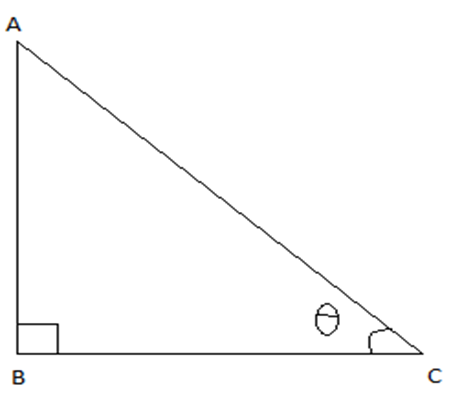Trigonometry
is the branch of mathematics which literally consists of three words. Tri referring
to three, gono meaning angle and metry which means measurement.
Hence, trigonometry refers to the measurement of triangles. We shall only deal
with right- angled triangles.
Right-angled triangle
A triangle having one angle 90˚ is known as right-angled triangle. The side opposite to right angle is called hypotenuse. It is denoted by ‘h’.
 In the figure, AC is the hypotenuse.
In the figure, AC is the hypotenuse. Reference Angle
An
angle that is taken into consideration before finding out perpendicular and
base in right-angled triangle is known as Reference angle. It is usually
denoted by Greek Alphabet. The side in front of the reference angle is called perpendicular
and the remaining side is called base. Perpendicular and base are denoted
by ‘p’ and ‘b’ respectively.
So, in short, p, b and h are the elements of right-angled triangle.
From figure, AB = Perpendicular (p)
BC
= Base (b)
AC
= Hypotenuse (h)
In any right-angled triangle the squares made on the
hypotenuse is always equal to the sum of the squares made on the remaining two
sides.
Mathematically, h2 = p2 + b2
Converse of Pythagoras
Theorem
Converse of Pythagoras Theorem states that if Pythagoras Theorem is h2 = p2 + b2 holds true then the triangle must be a right-angled triangle.
Here in
DEF,
DF = 10 cm, DE = 8 cm and FE = 6 cm.
We have to see whether the triangle is right-angled
triangle.
So, for DEF to be a right-angled triangle,
(DF)2 = (DE)2 + (EF)2 {DF is the longest side so it is considered
hypotenuse}
Or, (10)2
= (8)2 + (6)2
Or, 100 =
64 + 36
Or, 100 =
100 (true)
Since, Pythagoras theorem holds DEF is a right-angled
triangle. 
1. Find out p, b and h from the following right-angled triangle with the given angle of reference (i) R = θ be the reference angle. (ii) P = α be the reference angle.

Here, in right-angled ∆PQR, <Q = 90˚
(i). <R = θ
is the angle of reference,
Then, RP =
hypotenuse (h)
PQ = perpendicular (p)
RQ =
base (b)
Again,
(ii). <P = α
be the reference angle
Then, RP =
hypotenuse (h)
RQ =
Perpendicular (p)
PQ =
base (b)
2. Find the missing side from the right-angled triangle given below.

Here, in right-angled triangle ∆ABC,
<B = 90˚, AB = 5 cm, AC = 13 cm, BC =?
We know,
In right-angled ∆ABC
h2 = p2 + b2
so, (AC)2
= (AB)2 + (BC)2
or, (13)2
= (5)2 + (BC)2
or, 169 –
25 = (BC)2
or, (BC)2
= 144
or, (BC)2
= 122
or, BC =
12
hence, BC is 12 cm
3. Find the missing side from the right-angled triangle given below.

In right-angled ∆PQR,
(PR)2 = (PQ)2 + (QR)2
Or, (PR)2
= (3)2 + (4)2
Or, (PR)2
= 9 + 16
Or, (PR)2
= 25
Or, (PR)2
= (5)2
PR
= 5 cm
Now, in right-angled ∆PSR
(SR)2
= (PS)2 + (PR)2
Or, (SR)2
= (12)2 + (5)2
Or, (SR)2
= 144 + 25
Or, (SR)2
= 169
Or, (SR)2
= (13)2
SR
= 13 cm








0 Comments
Thank you for your feedback.